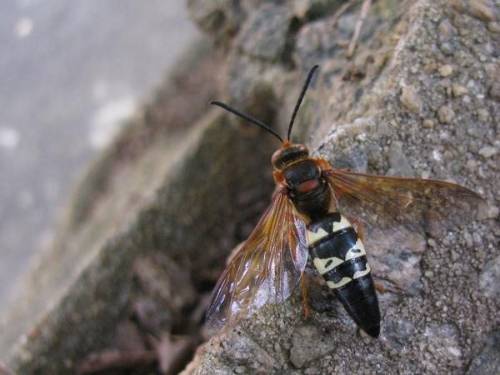Cicada Killer

The Eastern Cicada Killer is the largest wasp in Kansas and is a native of the United States east of the Rocky Mountains and down into Mexico. This large wasp can be up to an inch and a half long and weigh a gram. The adults have a rust to brown colored head with a black abdomen with three yellow bands. These wasps are often found congregating in the same areas, giving the appearance of a hive; however, that is simply because they are attracted to the same type of location for nesting. Cicada killers are solitary wasps, with the females digging a burrow in the ground and hunting to feed the young. The female will dig up to 4 burrows in her lifetime, which can be up to 40” deep and contain up to 16 chambers for young. These wasps hunt cicadas for food and will kill 100 or more cicadas in their lifetime. Females sting the cicada to stun and kill it, then drag it into the burrow, leaving one cicada with her male offspring and two to three with the females. She will then lay an egg, and the young will eat the cicadas over approximately 4 days before spinning a cocoon to wait till next spring when they pupate and emerge as adults. Control is usually unnecessary as males cannot sting, and females will rarely sting. The nests can occasionally damage turf and small plants, but spraying is typically unnecessary. If needed, spray can be applied directly to the burrow's entrance, but if the adults have left, the larvae will likely survive to hatch next year.

Have questions? Contact our office where our Horticulture Extension Agent will assist you with questions.
Phone: (316) 321-9660
Email: callae@ksu.edu